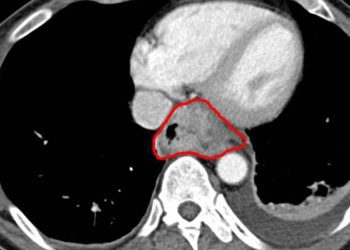Early Ramucirumab/Paclitaxel vs Continuation of First-line Chemotherapy in Advanced HER2-negative Gastric/Gastroesophageal Cancer
1. Median PFS was 6.6 months in the switch maintenance group and 3.5 months in the control group with HR 0.61 (significant).
2. Treatment-related adverse events grade 3 or worse occurred in 40% of the switch maintenance group vs 21% in the control group.
Evidence Rating Level: 1 (Excellent)
Study Rundown: Fluoropyrimidine and platinum-based chemotherapy are the standard first-line treatment for HER2-negative advanced gastric or gastroesophageal junction cancer followed by paclitaxel and ramucirumab as a second-line treatment. This study evaluated whether early switch maintenance therapy with paclitaxel and ramucirumab could provide superior outcomes to continued doublet fluoropyrimidine/platinum-based chemotherapy after an initial 3-month induction with FOLFOX or CAPOX regimens. The primary endpoint was progression-free survival (PFS) and secondary endpoints included overall survival (OS), overall response rate (ORR), time to treatment failure (TTF), and safety. Median PFS was 6.6 months in the switch maintenance group and 3.5 months in the control group with HR 0.61 (significant). Median OS was 12.6 months in the switch maintenance group and 10.4 months in the control group with HR 0.75 (significant). Both PFS and OS data were consistent across most clinical subgroups. An exploratory biomarker analysis was done and found that in patients with “triple-negative status” (PD-L1 combined positive score less than 5, negative for CLDN18.2, and had MMR proficiency), PFS was 7.0 months in the switch maintenance group and 4.1 months in the control group with HR 0.66 (non-significant). Median TTF was 6.2 months in the switch maintenance group and 3.1 months in the control group with HR 0.61 (significant). ORR was 19% (1% CR and 18% PR) in the switch maintenance group versus 16% (3% CR and 13% PR) in the control group with OR 1.26 (non-significant). Post-hoc analysis found that for patients with stable disease as the best response to induction chemotherapy, the HR for PFS was 0.42 (significant) and for OS was 0.46 (significant), and this was in comparison to patients with partial response, the HRs were 0.80 (non-significant) for PFS and 0.97 (non-significant) for OS. With regards to safety, treatment-related adverse events grade 3 or worse occurred in 40% of the switch maintenance group vs 21% in the control, with most frequent grade 3-4 events being neutropenia (26% in the switch maintenance group vs 10% in the control group), peripheral neuropathy (6% vs 7%) and arterial hypertension (6% vs 0%). The strengths of this study included its methodology and follow-up time, and the limitations included sample size. Overall, the benefit of switch maintenance (early paclitaxel/ramucirumab second-line therapy) showed some benefit in patients with advanced/metastatic HER2-negative gastric/gastroesophageal junction adenocarcinoma after 3-month induction chemotherapy with FOLFOX/CAPOX regimens.
Click to read the study in Lancet Oncology
Click to read an accompanying editorial in Lancet Oncology
In-Depth [randomized controlled trial]: This multicenter, open-label, phase 3 trial enrolled adults with advanced/metastatic HER2-negative gastric or gastroesophageal junction adenocarcinoma who completed 3-month induction chemotherapy with FOLFOX or CAPOX regimens, and randomized them (1:1) to either paclitaxel plus ramucirumab switch maintenance therapy (n=144) or continuation of oxaliplatin-based chemotherapy (n=136). Baseline patient groups were similar, however all were White and 64% were male. Median follow-up of 43.7 months (IQR 24.0-57.9). Median PFS was 6.6 months (95%CI, 5.9-7.8) in the switch maintenance group and 3.5 months (2.8-4.2) in the control group with HR 0.61 (95%CI, 0.48-0.79, p=0.0002). Median OS was 12.6 months (95%CI, 11.5-15.0) in the switch maintenance group and 10.4 months (8.0-13.1) in the control group with HR 0.75 (95%CI, 0.58-0.96, p=0.025). Both PFS and OS data were consistent across most clinical subgroups. An exploratory biomarker analysis was done and found that in patients with “triple-negative status” (PD-L1 combined positive score less than 5, negative for CLDN18.2, and had MMR proficiency), PFS was 7.0 months (95%CI, 5.7-11.9) in the switch maintenance group and 4.1 months (3.5-6.9) in the control group with HR 0.66 (95%CI, 0.39-1.11, p=0.12). Median TTF was 6.2 months (95%CI, 5.7-7.5) in the switch maintenance group and 3.1 months (2.8-3.9) in control group with HR 0.61 (95%CI, 0.48-0.78, p<0.0001). ORR was 19% (95%CI, 12-28, 1% CR and 18% PR) in the switch maintenance group versus 16% (95%CI, 10-24, 3% CR and 13% PR) in the control group with OR 1.26 (95%CI, 0.60-2.63, p=0.58). Post-hoc analysis found that for patients with stable disease as the best response to induction chemotherapy, the HR for PFS was 0.42 (95%CI, 0.29-0.62) and for OS was 0.46 (0.31-0.67), and this was in comparison to patients with partial response, the HRs were 0.80 (0.54-1.18) for PFS and 0.97 (0.65-1.45) for OS. With regards to safety, treatment-related adverse events grade 3 or worse occurred in 40% in the switch maintenance group vs 21% in the control, with most frequent grade 3-4 events being neutropenia (26% in the switch maintenance group vs 10% in the control group), peripheral neuropathy (6% vs 7%) and arterial hypertension (6% vs 0%). Overall, the benefit of switch maintenance (early paclitaxel/ramucirumab second-line therapy) showed some benefit in patients with advanced/metastatic HER2-negative gastric/gastroesophageal junction adenocarcinoma after 3-month induction chemotherapy with FOLFOX/CAPOX regimens.
Image: PD
©2024 2 Minute Medicine, Inc. All rights reserved. No works may be reproduced without expressed written consent from 2 Minute Medicine, Inc. Inquire about licensing here. No article should be construed as medical advice and is not intended as such by the authors or by 2 Minute Medicine, Inc.





